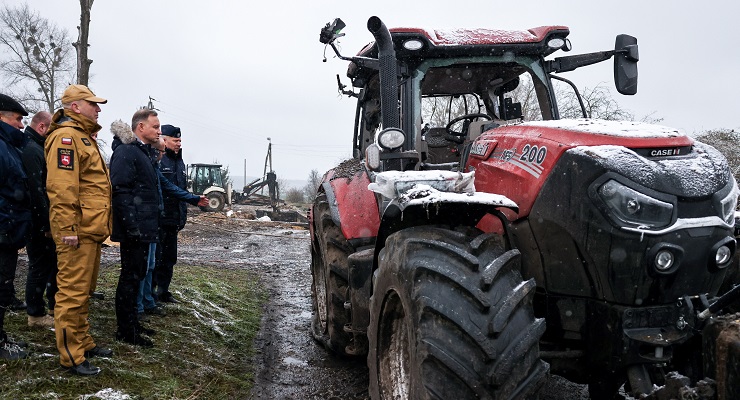
It’s still inconclusive who fired the missile that landed in Poland on Tuesday and killed two people, but it has not stopped world leaders, analysts, and self-proclaimed Twitter experts jumping the gun and hypothesising whodunnit.
“Sometimes they get an individual arms ID right, but the context is wrong — and that’s often where the harm lies,” arms and munitions intelligence specialist N R Jenzen-Jones told Crikey.
“There’s a lot of people out there just competent enough to be dangerous.”
The consequences of a quick-to-blame game in weapons identification can be deadly. This week NATO allies toyed with the prospect of an all-in conflict as leaders entertained the “unlikely” idea that the strike was an act of Russian aggression and the more likely scenario that it was the work of an awry Ukrainian air defence missile responding to a Russian provocation.
Both Russia and Ukraine have denied ownership of the missile. Putin ally and former Russian president Dmitry Medvedev said the West was angling for WWIII; US President Joe Biden drip-fed intelligence with talk of trajectories; NATO’s secretary general Jens Stoltenberg absolved Ukraine of wrongdoing even if the missile had a Ukrainian ID; and Polish President Andrzej Duda called for evidence-based calm.
Meanwhile, a thorough investigation into the incident is underway. Not only will it put a name to the missile, but it will establish cause and context. In short: who, how, why.
So what’s the proper process of ID-ing a weapon and bringing its backstory to life?
“Ultimately, when analysing a specific incident, the investigator is trying to draw a clear line between the guy who picked up the phone or radio and gave an order, and the harm that was inflicted at the other end,” Jenzen-Jones said.
There’s intel available both pre- and post-blast. Pre-blast gives the critical context (target location, military activity, and arsenal in the area), while post-blast provides physical evidence (damage to buildings, craters, casualties, and munition remnants on the ground and in humans).
“You’re asking questions about why someone would attack that site, whether or not what you are seeing is an intentional act, what the decision-making process might be,” he said.
So where to begin picking up the pieces?

Jenzen-Jones said you go big before you go small. First step is to select a “class” — a choice between small weapons, light weapons, heavy weapons, and munitions.
Within these four killer categories are “groups”. The investigators deploy a divide-and-conquer strategy based on the aesthetic of the arms. For what it’s worth, a “long gun” is separated (at a safe distance) from a “hand gun”.
Then comes “type”, which is a further fragmentation of parts according to function. The final phase of “classification” is “method of operation”, which is ultimately how a machine is managed by its master.
That’s the PID (positive ID) part. In order to get a UID (unique ID) on a weapon, “make and model” are key. This is the missile equivalent of a Ford Taurus. Batch, lot, and serial number combined with physical characteristics including tool marks, geometric patterns, stripes, and engravings are all tell-tale signs.
“When a make, model name, or other key information is written on the weapon it’s very easy,” said Jenzen-Jones, adding that it’s “very uncommon, but not unheard of” to find “sanitised” (de-identified) or counterfeit weapons.
Why? Manufacturers aren’t generally making products for the purposes of guerrilla warfare, resources are scarce in war so nations draw on whatever they have at their disposal, and there are sadly “few consequences if you do get caught”.
But more often, damage to the weapon upon impact renders it difficult to identify, deforming distinctive shapes and obliterating markings. And so it’s over to the field of forensics. Buried in the fine print are characteristics like choice of font and chemical composition of paint.
The process of identification in the Polish case should be “relatively easy”, said Jenzen-Jones, because it is a “single munition incident”. Often blast sites are bombarded with an array of arms, making it difficult to disaggregate what’s what and who’s who. Even more so when chemical weapons are involved.
But all of this is contingent on context. And for that, the full picture is key. It’s the difference, said Jenzen-Jones, between a “regrettable accident, a negligent mistake, or a deliberate attack”.








Identifying the type of missile and who made it is important of course. But it does not reveal who fired it or why. Countries at war often make use of captured weapons in addition to their own, and sometimes they do it to create confusion. There’s a lot more required to make a convincing and comprehensive account of this incident.
Agreed SRS, but what is important here is the propaganda and blame/condemnation potential.
There will be more deaths in NATO countries associated with lack of energy as a consequence of the blowing up (Act of terrorism is the correct term.) of the Nord Stream pipelines – but that’s now been swept under the carpet. It achieved the desired result for the perpetrator. All are towing the line.
If the language on its parts is written in Ukrainian, then one could assume it was used by Ukrainians.
By cosmic coincidence I happened to be listening to Melvyn Bragg’s ‘In Our Time’ BBC podcast about the vast Polish-Lithuanian confederation, founded in 1385 which over 400yrtrs extended from the Baltic to the Black Sea including all of the Ukraine.
It gave the Continent the first working republic – res publica – with elected kings & queens.
I too have heard that podcast. I don’t think it claims that was the first republic on the continent. There are plenty of earlier ones. But the Polish-Lithuanian Commonwealth was a truly remarkable attempt to put together a federation of states that functioned as a whole while respecting their individual aspirations, and it worked until external enemies realised how they could exploit the rights of the minorities in the federation, which are necessary to keep them willing to stay within it, by corrupting some representatives to act in ways using those rights that paralysed the entire government.
It’s a method that still works when a federal constitution depends on the constituent parts resolving their differences in a spirit of compromise. Remove that spirit, and the federation is doomed. The enemies of such federations know this.
The MH17 case tells us that the people who brought a missile into Ukraine which was later fired and which killed innocent civilians, even though they did not “press the button themselves”, are guilty of murder and deserve life sentences.
It would be a great revolution in the conduct of the world if, following that example, there was general acceptance that anyone who supplies a weapon is responsible for the consequences of any subsequent misuse, and shall face justice accordingly. But I think we might have to wait a while. Bob Dylan put it like this years ago,
Come, you masters of war
You that build the big guns
You that build the death planes
You that build all the bombs
You that hide behind walls
You that hide behind desks
I just want you to know
I can see through your masks
You that never done nothing
But build to destroy
You play with my world
Like it’s your little toy
You put a gun in my hand
And you hide from my eyes
And you turn and run farther
When the fast bullets fly
Etc.
The best ending –
“And I hope that you die
And your death will come soon
I will follow your casket
By the pale afternoon
And I’ll watch while you’re lowered
Down to your deathbed
And I’ll stand over your grave
‘Til I’m sure that you’re dead!”
Mh17 can be cleared up once and for all if the US released its satellite data, they had one overhead on that particular day. Silence can also make you guilty if you know the facts.
Classic case of ‘the dog that didn’t bark’ – had they any hint of the true source of the BUKA it would have been proclaimed loud & long.
At least they jumped in, sotto voce, to ‘clarify’ the “Russian missile attack on Poland”.
It was a rerun of “Russians attack refugee train station/hospital/kindergarten etc ad nauseam“, not forgetting the weeks of ‘Russians shell Zaporizhzhia nuke power plant’ – the one they were guarding, occupying and ensuring it provided the regime with electricity for first 6 months throughout the war.
So who made the four cylinder horizontally opposed engine in the exploded drone photographed on the ground in Ukraine, with the word Engine in English and an eight digit serial number alongside stamped into the engine block?